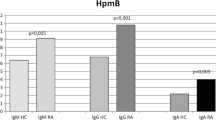Abstract
The aim of this study is to determine whether treatment increases the levels of anti-Proteus antibodies (APA) in patients with rheumatoid arthritis (RA). The blood samples of 32 patients suffering from RA who were recruited in our previous study and continued to participate in our follow-up study were collected after 1 year. Their first and follow-up samples were analysed for the presence of IgG isotype and total immunoglobulins (IgG+IgA+IgM) against Proteus mirabalis (PM) using enzyme-linked immunosorbent assay with two kinds of antigen preparations: whole bacteria and sodium dodecyl sulphate (SDS) lysed bacterial extract. All patients were treated with methotrexate and hydroxychloroquine with adequate dose of non-steroidal anti-inflammatory drug. After 1 year, 11 patients were in clinical remission [erythrocyte sedimentation rate (ESR) less than 30 mm/h and C-reactive protein (CRP) less than or equal to 10 mg/l], while the rest of the 21 were in the state of active disease. Correlation and Student's t test were used for statistical analysis. APA titres were significantly elevated in patients after 1 year of therapy. However, the rise was not different between patients who were in clinical remission and those in the state of active disease. APA titre increases in the treatment of RA, and the probable mechanisms are discussed.


Similar content being viewed by others
References
Ebringer A, Ptaszynska T, Corbett M, Wilson C, Macafee Y, Avakian H, Baron P, James DCO (1985) Antibodies to Proteus in rheumatoid arthritis. Lancet ii:305–307
Tiwana H, Wilson C, Alvarez A, Abuknesha R, Bansal S, Ebringer A (1999) Cross-reactivity between the rheumatoid arthritis associated motif EQKRAA and structurally related sequences found in Proteus mirabilis. Infect Immun 67(6):2769–2775
McDonagh J, Gray JW, Sykes H, Walker DJ, Bint AJ, Deighton CM (1994) Anti-Proteus antibodies and Proteus organisms in rheumatoid arthritis: a clinical study. Br J Rheumatol 33(1):32–35
Senior BW, Anderson GA, Morley KD, Kerr MA (1999) Evidence that patients with rheumatoid arthritis have asymptomatic ‘non-significant’ Proteus mirabilis bacteria more frequently than healthy controls. J Infect 38(2):99–106
Chandrashekara S, Ramesh MN, Shobha A, Sarvanan Y et al (2003) Proteus mirabilis and rheumatoid arthritis: no associations with disease. Clin Rheumatol 22:218–220
Maki-Ikola O, Lehtinen K, Grantoss K, Vainionpaa R, Taivanen P (1991) Bacterial antibodies in ankylosing spondylitis. Clin Exp Immunol 84:472–475
Maki-Ikola O, Hellgreen R, Karnecud L, Feltelius N, Knutsson L, Grantoros K (1997) Enhanced jejunal production of antibodies to Klebsiella and other enterobacteria in patients with ankylosing spondylitis and rheumatoid arthritis. Ann Rheum Dis 56:421–425
Bjarnason I et al (1987) Nonsteroidal anti-inflammatory drug-induced intestinal inflammation in humans. Gastoenterology 93:480–489
Uejima M, Kinouchi T, Kataoka K, Hiraoka I, Ohnishi Y (1996) Role of intestinal bacterial in ileal ulcer formation in rats treated with a nonsteroidal inflammatory drug. Microbiol Immunol 40(8):553–560
Bjarnason I, Peters TJ (1996) Influence of anti-rheumatic drugs on gut permeability and on the gut associated lymphoid tissue. Bailliere's Clin Rheumatol 10:165–176
Berg RD, Wommack E, Deitch EA (1998) Immunosuppression and intestinal bacterial overgrowth synergistically promote bacterial translocation. Arch Surg 123(11):1359–1364, November
Bjarnason I, Zanelli G, Smith T et al (1987) The pathogenesis and consequence of non-steroidal anti-inflammatory drug induced small intestinal inflammation in man. The pathogenesis and consequence of non-steroidal anti-inflammatory drug induced small intestinal inflammation in man. Scand J Rheumatol Suppl 64:55–62
Author information
Authors and Affiliations
Corresponding author
Rights and permissions
About this article
Cite this article
Chandrashekara, S., Patil, R., Vadiraja, H.S. et al. The incidence of Proteus mirabilis infection increases in patients on treatment but does not trigger disease activity. Clin Rheumatol 25, 520–523 (2006). https://doi.org/10.1007/s10067-005-0090-4
Received:
Revised:
Accepted:
Published:
Issue Date:
DOI: https://doi.org/10.1007/s10067-005-0090-4




